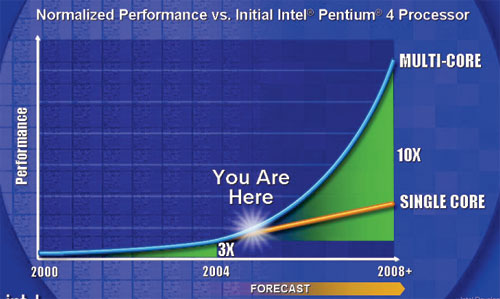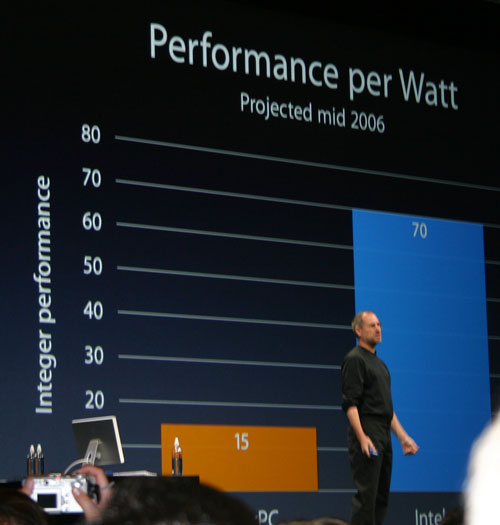Intel's Core 2 Extreme QX6700: The Multi-core Era Begins
by Anand Lal Shimpi on November 2, 2006 2:14 AM EST- Posted in
- CPUs
More Cores - The Ticket to Power Efficiency?
When Intel started on its quest for greater power efficiency we heard much about how the ticket would be more cores and multi-threaded applications. Instead of focusing on increasing clock speed Intel turned to the world and admitted that its gigahertz race was foolish, and that the next decade of performance improvements would come from increasing the number of cores per processor, not clock speed.
Back in 2005 Intel displayed the following chart, plotting a new curve for performance made possible mostly by the move to multi-core processors:

But at the same time, just as Intel had learned from the Pentium 4 family, an endless pursuit of performance (whether in the form of higher clock speed or more cores) will simply run us into another power wall. So as we were hearing about the performance improvements the multi-core era would bring us, we were also being told that Intel would not only improve the performance vector, but performance-per-watt as well. In fact, Apple cited Intel's focus on performance-per-watt as the driving factor in its adoption of Intel CPUs:

The introduction of Intel's Core microarchitecture proved one very important point: individual core improvements, as well as simply adding more cores, will both be necessary to drive better performance per watt in future microprocessors.
Looking at Intel's own numbers, the move from one to two cores improved performance per watt on the mobile side by around 50% while the move from NetBurst to Core on the desktop side increased performance per watt by a magnitude of 5x.
But is Kentsfield nothing more than a cleverly masked return to an older Intel? An Intel that used its manufacturing abilities to out-market AMD but left us with much higher power consumption than we wanted (and needed) to have? With Kentsfield we have two Conroes on a single chip, with no tweaks to the cores and very inefficient power management between the two die. Is this really no different than when Intel simply pushed out CPUs with higher clock frequencies, without addressing efficiency, to really turn up the heat on AMD?
Intel has said that it is committed to improving performance and performance per watt, but it was time to test that commitment with Kentsfield.
To put Intel's marketing and IDF presentations to the test we took six of our multithreaded benchmarks and ran them on a handful of configurations. Instead of just measuring performance, we also looked at average power usage during the benchmark and obviously, performance per watt. While all six benchmarks benefit from dual core CPUs, only four of them show a gain when using a quad core CPU, which should be useful in illustrating a very important correlation between number of threads and performance per watt.










59 Comments
View All Comments
JJWV - Tuesday, January 23, 2007 - link
I bought a QX6700 for crunching at numbers. The reasoning was simple twice the power, only one MB, disk, PSU, case...The result is disappointing, the maximum throughput I get is not twice an E6700, it is just a little more than one an half : 1,6 to be precise. The bottleneck is definitely the memory. The Northbridge cannot communicate fast enough with the memory. 5I came to this conclusion by varying multiplier, FSB...) Perhaps it would be worthwhile with the faster memory available 9200, but I am afraid even that kind of memory is to slow. The Quadcore is where Intel went over the edge with their memory architecture.
Kougar - Tuesday, November 14, 2006 - link
Any ideas on the Apache benchmarks I am seeing with a QX6700? They are appalling at best, with a QX6700 performing on par to a E6400!! A little of the same problem seems to have shown up in Office Productivity benchmarks. Any thoughts on this?in1405 - Monday, November 6, 2006 - link
<<<No article looking at a new processor release would be complete without benchmarks. However, let us preface the benchmark section by stating that the benchmarks don't tell the whole story. There are numerous benchmarks and tasks that you can run that will actually show quad core processors in a better light. A lot of people will never use the applications related to these benchmarks, so in one sense we could say that most people should already know whether or not they need quad core processing.>>>Some interesting comments here on the relevance of Benchmarks .. This looks interesting as this point of view never came up while the AMD CPUs were being glorified a few months back in this same site!! Wonder where the sudden wisdom comes from.
LTC8K6 - Sunday, November 5, 2006 - link
Why not compare dual to quad by trying to run things in the background while you do something in the foreground? Encode something and play Oblivion, for example. Would we finally be able to do anything like that with quad cores? Are we able to get good framerates in such a situation yet?Webgod - Thursday, November 2, 2006 - link
How about running http://www.driverheaven.net/photoshop/">DriverHeaven.Net's Photoshop CS2 benchmark? I think one of your standard magazine benchmarks has Photoshop 7, but the DH benchmark is newer and it's somewhat popular. Anybody can download a demo from Adobe, and run the benchmark on their own PC.coldpower27 - Thursday, November 2, 2006 - link
Check Intel's current price list here:http://www.intel.com/intel/finance/pricelist/proce...">http://www.intel.com/intel/finance/pricelist/proce...
JarredWalton - Thursday, November 2, 2006 - link
Actually just the 820 and 914 - 805 didn't get a price cut this month. But I fixed the other two, thanks. :)coldpower27 - Thursday, November 2, 2006 - link
oh yeah my bad, didn't mean to add the 805 in there.by the way, check your email please.
OddTSi - Thursday, November 2, 2006 - link
On page 7 you say "Apple's OS X and its applications have also been well threaded for quite some time..." yet the only two Apple apps in the test (Quicktime and iTunes) didn't scale AT ALL from 2 to 4 cores. I'm not trying to bash Apple here I'm just trying to point out that the facts don't seem to support your assertion. If Apple's media rendering apps - which are some of the easiest to multithread - don't scale well I doubt that the rest of their apps do.mino - Thursday, November 2, 2006 - link
Maybe cause there is a catch?You see, WinXP is not very OSX like, not to mention its apps ;)